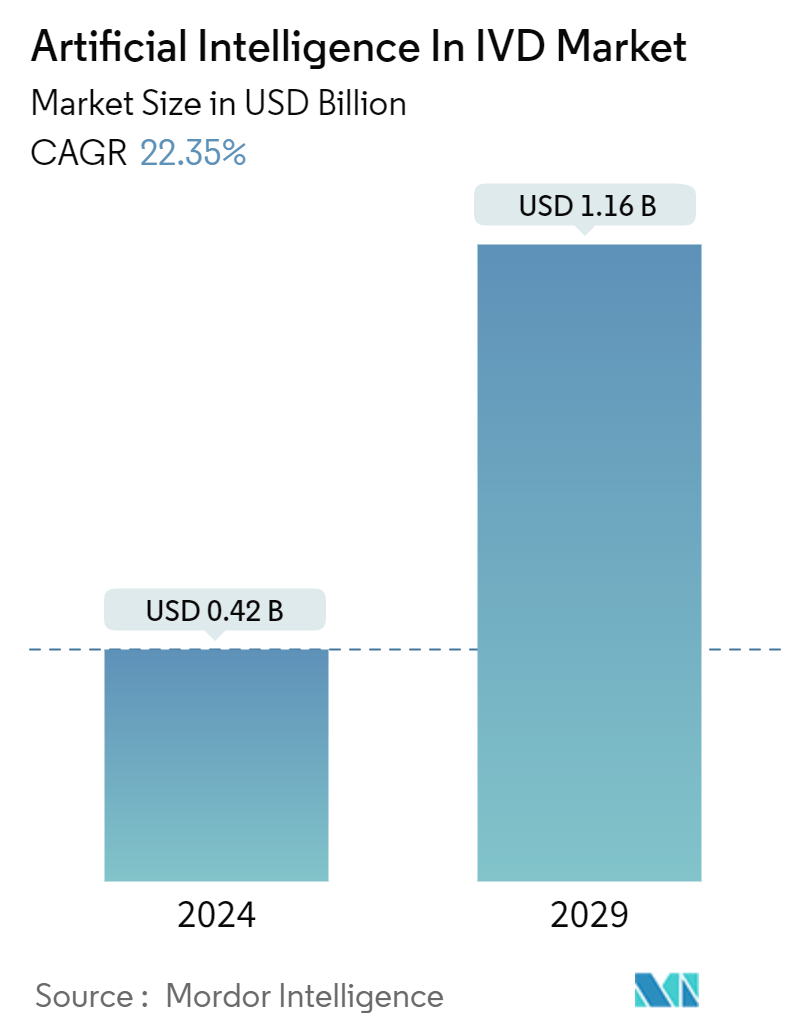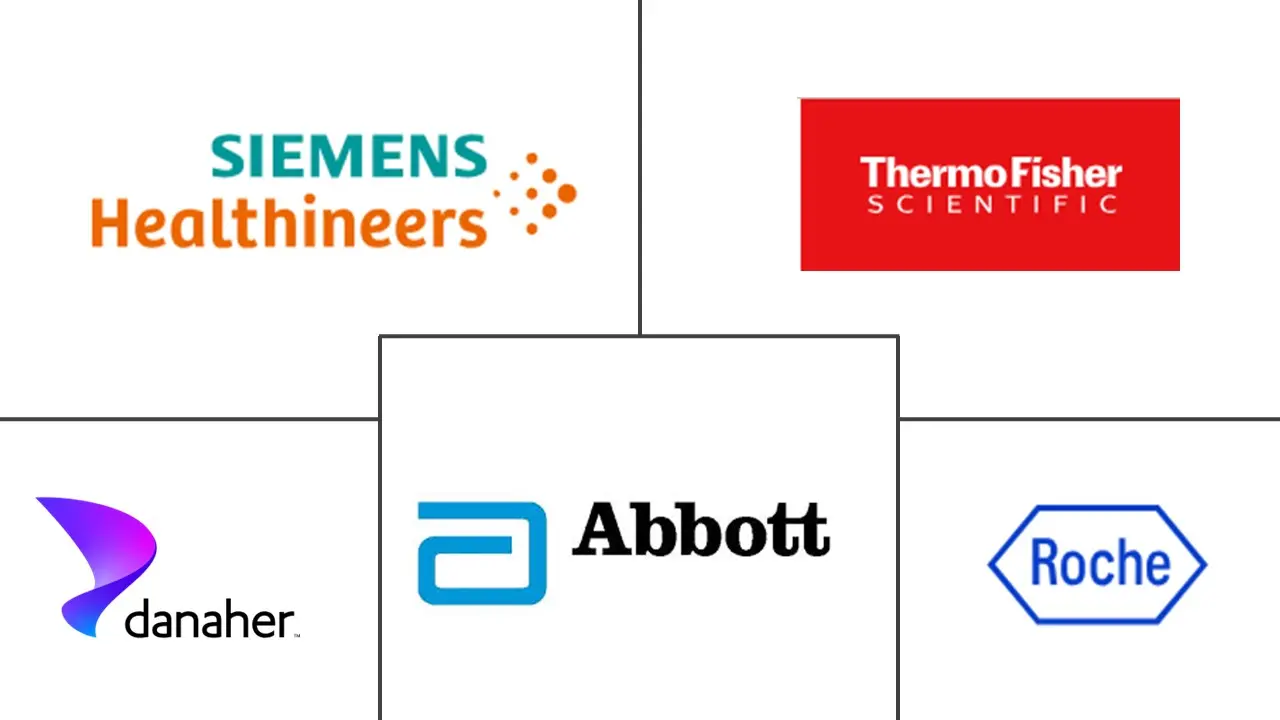Market Size of Artificial Intelligence In IVD Industry

| Study Period | 2019 - 2029 |
| Market Size (2024) | USD 0.42 Billion |
| Market Size (2029) | USD 1.16 Billion |
| CAGR (2024 - 2029) | 22.35 % |
| Fastest Growing Market | Asia Pacific |
| Largest Market | North America |
Major Players
*Disclaimer: Major Players sorted in no particular order |
Artificial Intelligence In IVD Market Analysis
The Artificial Intelligence In IVD Market size is estimated at USD 0.42 billion in 2024, and is expected to reach USD 1.16 billion by 2029, growing at a CAGR of 22.35% during the forecast period (2024-2029).
The growing burden of chronic and infectious diseases, rising demand for early disease detection, and advancements in artificial intelligence (AI) technology are expected to boost the expansion of artificial intelligence in the IVD market.
The prevalence of chronic diseases such as diabetes, cardiovascular disorders, and cancer is increasing globally. AI technologies are being increasingly utilized to enhance diagnostic accuracy, efficiency, and personalized treatment options for these conditions. By analyzing large datasets and identifying patterns that human experts may miss, AI in IVD enables earlier disease detection, better risk assessment, and more effective management strategies. For instance, according to the British Heart Foundation, in January 2024, around 7.6 million people in the United Kingdom lived with heart and circulatory diseases in 2023.
As per the same source, around 4 million males and 3.6 million females in the United Kingdom lived with heart and circulatory diseases in 2023. Studies suggest that over half of the United Kingdom population will likely develop a heart or circulatory condition during their lifetime. Thus, the rising cases of cardiovascular disease are driving the market by enabling early detection through advanced data analysis, predicting disease progression, enhancing imaging analysis accuracy, and providing clinical decision support.
Also, AI offers advanced capabilities to analyze extensive patient data and detect disease indicators at early stages. For instance, an article published by Sensors in August 2022 stated that the AI-powered universal diagnostic system has undergone rigorous validation in extensive clinical studies, demonstrating its effectiveness in identifying early disease detection markers and assessing disease severity across various applications such as cardiovascular diseases, COVID-19, and oral cancer. Thus, AI's ability to analyze complex data from imaging enables accurate and timely disease detection, supports personalized medicine, and improves overall healthcare efficiency, which will be anticipated to drive the growth of the market during the forecast period.
Hence, due to the aforementioned factors, such as the growing cases of cardiovascular disease and the rising capabilities of AI for early disease detection, the market is expected to continue to grow in the coming years. However, stringent regulatory approval processes and data privacy and security concerns significantly hinder the adoption of AI during the forecast period.
Artificial Intelligence In IVD Industry Segmentation
As per the scope of the report, artificial intelligence (AI) in in-vitro diagnostics (IVD) refers to the use of computational algorithms and machine learning techniques to analyze diagnostic data, interpret results, and provide insights that enhance accuracy, efficiency, and clinical decision-making in laboratory testing and medical diagnostics. The AI in the IVD market is segmented by application, technology, end user, and geography. By application, the market is segmented into oncology, infectious disease, cardiology, and other applications. By technology, the market is segmented into machine learning, deep learning, and other technologies. By end user, the market is segmented into hospitals and clinics, diagnostic laboratories, and other end users. By geography, the market is segmented into North America, Europe, Asia-Pacific, and Rest of the World. The report offers the value (in USD) for the above segments.
| By Application | |
| Oncology | |
| Infectious Disease | |
| Cardiology | |
| Other Applications |
| By Technology | |
| Machine Learning | |
| Deep Learning | |
| Other Technologies |
| By End User | |
| Hospitals and Clinics | |
| Diagnostic Laboratories | |
| Other End Users |
| Geography | ||||||||
| ||||||||
| ||||||||
| ||||||||
| Rest of the World |
Artificial Intelligence In IVD Market Size Summary
The artificial intelligence in in vitro diagnostics (IVD) market is poised for significant growth, driven by the increasing prevalence of chronic and infectious diseases and the rising demand for early disease detection. AI technologies are enhancing diagnostic accuracy and efficiency by analyzing large datasets to identify patterns that may be overlooked by human experts. This capability is particularly beneficial in managing chronic conditions such as diabetes, cardiovascular disorders, and cancer, where early detection and personalized treatment options are crucial. The market is further propelled by advancements in AI that enable better risk assessment and more effective management strategies, thereby improving healthcare outcomes. However, the adoption of AI in IVD is challenged by stringent regulatory approval processes and concerns regarding data privacy and security.
In North America, the market is experiencing robust growth due to the increasing demand for early disease detection, government funding, and technological advancements. The rising incidence of cancer has accelerated the adoption of AI in the IVD market, enhancing early detection capabilities and supporting personalized medicine approaches. Government investments in machine learning and AI, along with innovations in platforms like Google Cloud's Medical Imaging Suite, are expected to drive market expansion. The competitive landscape is moderately fragmented, with major players focusing on regulatory approvals and product launches to strengthen their market presence. Companies such as Abbott, F. Hoffmann-La Roche Ltd, and Siemens Healthineers AG are key players in this evolving market, contributing to the transformative impact of AI in healthcare diagnostics.
Artificial Intelligence In IVD Market Size - Table of Contents
-
1. MARKET DYNAMICS
-
1.1 Market Overview
-
1.2 Market Drivers
-
1.2.1 Growing Demand for Early Disease Detection
-
1.2.2 Advancements in AI Technology
-
1.2.3 Rising Burden of Chronic and Infectious Diseases
-
-
1.3 Market Restraints
-
1.3.1 Stringent Regulatory Approval Processes
-
1.3.2 Data Privacy and Security Concerns
-
-
1.4 Porter's Five Force Analysis
-
1.4.1 Threat of New Entrants
-
1.4.2 Bargaining Power of Buyers/Consumers
-
1.4.3 Bargaining Power of Suppliers
-
1.4.4 Threat of Substitute Products
-
1.4.5 Intensity of Competitive Rivalry
-
-
-
2. MARKET SEGMENTATION (Market Size by Value - USD)
-
2.1 By Application
-
2.1.1 Oncology
-
2.1.2 Infectious Disease
-
2.1.3 Cardiology
-
2.1.4 Other Applications
-
-
2.2 By Technology
-
2.2.1 Machine Learning
-
2.2.2 Deep Learning
-
2.2.3 Other Technologies
-
-
2.3 By End User
-
2.3.1 Hospitals and Clinics
-
2.3.2 Diagnostic Laboratories
-
2.3.3 Other End Users
-
-
2.4 Geography
-
2.4.1 North America
-
2.4.1.1 United States
-
2.4.1.2 Canada
-
2.4.1.3 Mexico
-
-
2.4.2 Europe
-
2.4.2.1 Germany
-
2.4.2.2 United Kingdom
-
2.4.2.3 France
-
2.4.2.4 Italy
-
2.4.2.5 Spain
-
2.4.2.6 Rest of Europe
-
-
2.4.3 Asia-Pacific
-
2.4.3.1 China
-
2.4.3.2 Japan
-
2.4.3.3 India
-
2.4.3.4 Australia
-
2.4.3.5 South Korea
-
2.4.3.6 Rest of Asia-Pacific
-
-
2.4.4 Rest of the World
-
-
Artificial Intelligence In IVD Market Size FAQs
How big is the Artificial Intelligence In IVD Market?
The Artificial Intelligence In IVD Market size is expected to reach USD 0.42 billion in 2024 and grow at a CAGR of 22.35% to reach USD 1.16 billion by 2029.
What is the current Artificial Intelligence In IVD Market size?
In 2024, the Artificial Intelligence In IVD Market size is expected to reach USD 0.42 billion.

